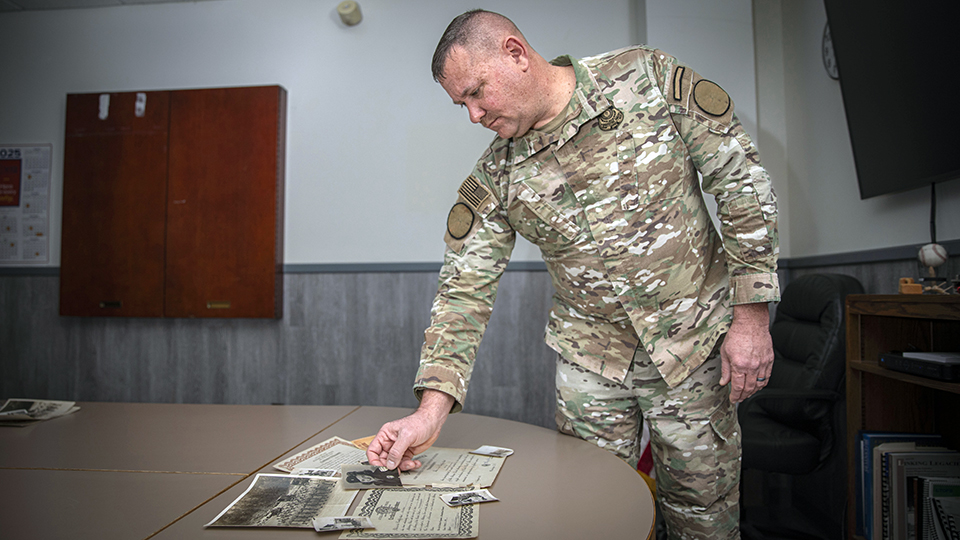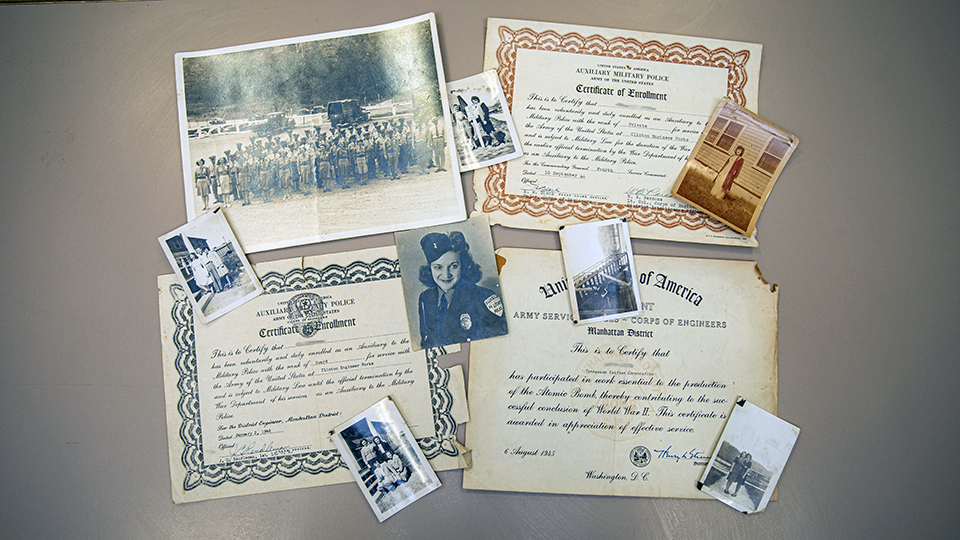Challenge Coin Connects Generations

Matthew S. reflects on being in the same Protective Force as his Mamaw 80 years later.
When Matthew S. walked into a conference room to give a challenge coin to Director of Protective Force Operations and Training Sean K., he did not expect to see a photo of his grandmother on the wall. But there she was in black and white. The lady he affectionately called Mamaw passed away in 2000, but her time as a guard at Y‑12 still lives on through pictures — and through her grandson.
After retiring from his 20‑year career as a police officer and completing a degree in criminal justice at Bethel University, Matthew joined Y‑12’s Protective Force in 2020. Shortly after Sean K. was hired, Matthew remembers walking into the conference room with him and saying, “There’s my Mamaw,” while pointing out his grandmother in a photo featuring the Y‑12 Guard Department from 1945, which was displayed in the room.
Sean K., who was surprised an employee recognized someone from the Manhattan Project‑era photo, asked how Matthew knew, to which he responded he had seen the picture before in his grandmother’s picture book and could pick her out: front row, third from the left.
“I brought in pictures to show Sean featuring Mamaw and another woman — my great aunt Gladys, who also worked at Y‑12. Gladys was not a guard but worked on the site.”
Y‑12’s history is filled with fathers and sons, mothers and daughters, and a workforce that often spans generations among East Tennessee families. But the decades‑long link between Matthew and his grandmother stands out.
Mamaw’s actual name was Helen B. She joined the Auxiliary Military Police at Y‑12 — then known as Clinton Engineer Works — in September 1944. She first joined as a private and then received the rank of guard in January 1946.
“Mamaw did not tell me much about her time at Y‑12; she only mentioned working here a few times during my childhood,” Matthew said.
However, he knows that she was 21 when she was hired and that Y‑12 was the only place she ever worked. He also has memorabilia from her time working at the site, including her certificates of enrollment and photos of her in her uniform.
Helen is one of just nine women who are in the group picture from 1945. In commemoration of her service to the country, Helen received a certificate highlighting the importance of her work for the production of the atomic bomb and the successful conclusion of World War II.
The end of the war brought hope not only for the country and the world but also for Helen, who was waiting for her fiancé, Shelby C., to return from overseas.
When Matthew’s papaw [one of the troops that stormed the Normandy beaches] arrived home from World War II, Helen left work at Y‑12 to marry him and become Helen C. They went on to have four children, the eldest being Matthew’s mother.
“She was a very kind and loving woman,” Matthew said. “A good mother, grandmother, and a good provider. She went to church regularly. She basically raised me and my sister until we went to school.”
Matthew feels the connection to his grandmother is an important one. He did not anticipate ending up at Y‑12 in his career, but he said he is proud to be in the same place she was.
“I know she would be proud of where I am today,” Matthew said. “I wish she was alive to see me working here like she did.”
“What a legacy to be part of the same Protective Force your grandmother served in during the Manhattan Project. It shows that Y‑12 truly is a family environment that has fostered generations of dedication to our region and national security as a whole,” King said.
Matthew added, “Being in the same Protective Force 80 years later is somewhat overwhelming. In 1945, she probably never thought that in 2025, her grandson would be walking the same steps, going in some of the same places that she did. Although some of our job duties may differ now, the mission is still the same, and Y‑12 is still here.
“I’m proud to be here in the same division that she was, and I wouldn’t be alive and here today at Y‑12 had it not been for her.”
When asked what his favorite thing about being a Y‑12er was, he shared, “I feel appreciated here,” which is likely why the legacy of working at Y‑12 often spans generations.
As it turns out, the legacy Helen unknowingly left behind could continue through the next generation, as one of Matthew’s children graduates college in May and already wants to come to work at Y‑12 like his father and great‑grandmother before him.

Among her personal memorabilia is the certificate highlighting the importance of Helen’s work for the production of the atomic bomb and the successful conclusion of World War II.
